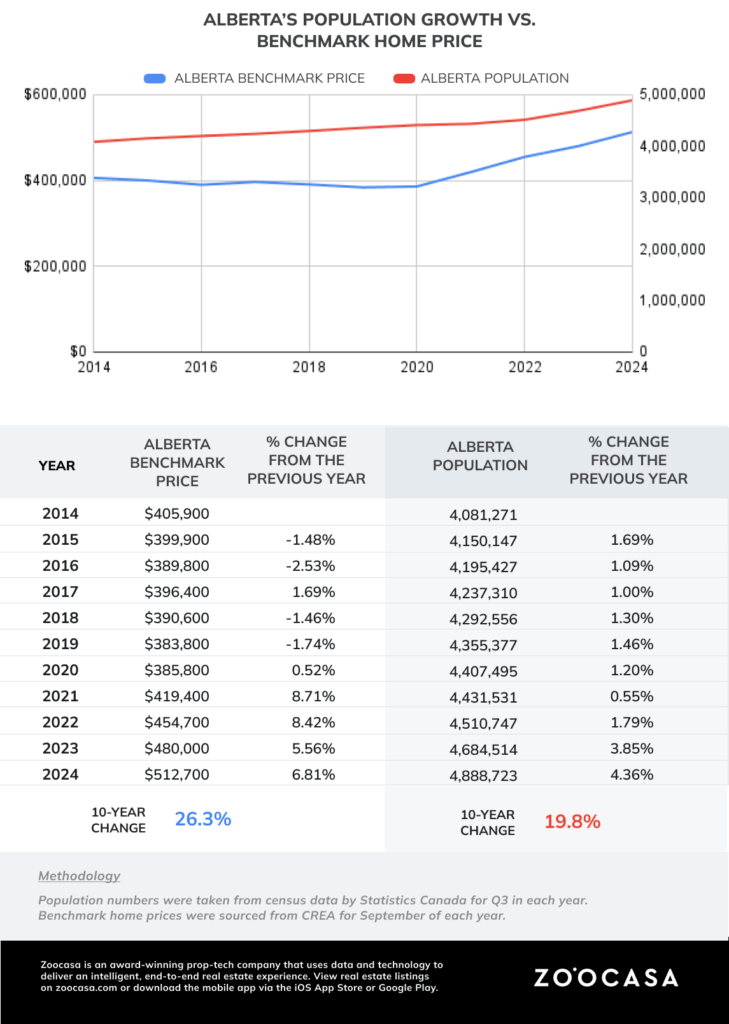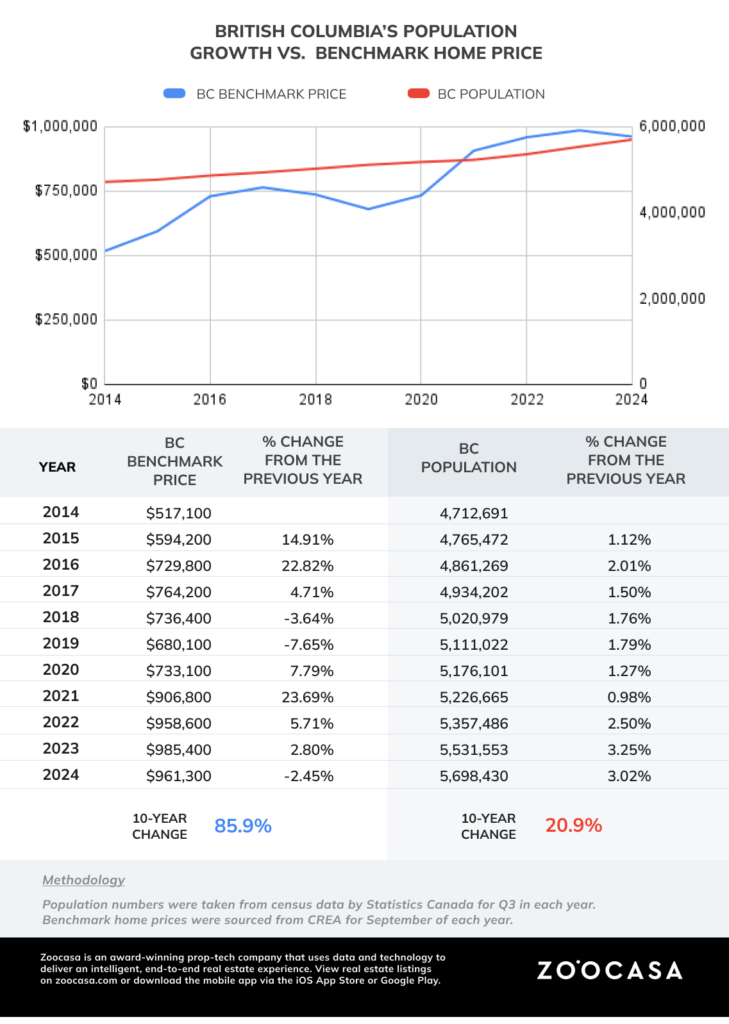One of the biggest Canadian news stories of 2023 was the national population surpassing 40 million for the first time. This year, Canada’s population has already exceeded 41 million and is projected to reach 62.8 million people by 2073, according to Stats Can.
However, population growth is not distributed equally across the provinces. Some provinces are home to a large number of international immigrants or temporary residents, while others are seeing a large boost in their population due to interprovincial migration. Whatever the cause, population growth historically leads to increased housing demand, which in turn contributes to a rise in home prices.
Partly for this reason, and wider economic concerns, the Canadian government recently announced plans to reduce the number of permanent residents allowed into the country in 2025 and 2026, cutting the intake by 21%. But how strongly is population growth linked to rising home prices? And how has it impacted home price growth in each province?
To find out, Zoocasa analyzed population records and provincial benchmark prices for the past 10 years using Statistics Canada and the Canadian Real Estate Association data. (Note: Manitoba was excluded from this report because CREA does not report on Manitoba’s benchmark home price).
Home Price Growth Outpaces Population Growth in Every Province
In the nine provinces analyzed, benchmark home price growth from 2014 to 2024 was significantly higher than population growth over the same period. Population growth is often linked to driving home prices up. However, with prices rising at much faster rates than population growth, it is likely that other factors—such as interest rates, housing availability, shifting demand, government policies, and economic conditions—are also at play.
From 2014 to 2024, Prince Edward Island experienced both the largest percentage increase in its population and the most significant percentage increase in its benchmark home price. Prince Edward Island’s population increased by 23.9% from 144,095 in 2014 to 178,550 in 2024, while its benchmark price more than doubled in ten years. The benchmark home price currently sits at $372,200, putting the province ahead of New Brunswick, Saskatchewan, and Newfoundland & Labrador.
British Columbia experienced the next largest percentage increase in its population growth at 20.9%, while Ontario showed the second-largest percentage increase in its benchmark home price at a whopping 101.7%. Nova Scotia’s benchmark price also doubled in the last ten years, rising from $203,800 to $410,900, marking a 101.6% increase.
Meanwhile, Newfoundland & Labrador and Saskatchewan remain the most stable and least changing among the analyzed provinces. In ten years, Newfoundland & Labrador’s benchmark price increased by 16.2%, or $42,700, while the population increased by only 3.3%. Similarly, in Saskatchewan, the benchmark price increased by 16.8% and the population increased by 11.5%.


A Closer Look at Alberta’s Population Growth
Alberta has long been in the spotlight for its rapid population growth, with the latest numbers showing a 4.4% increase from Q3 2023 to Q4 2024—the highest of any province. However, despite experiencing the third-largest percentage increase (19.8%) in its population from 2014, the benchmark home price in Alberta has only increased by 26.3% in ten years. This represents the third-smallest increase, following Newfoundland & Labrador (16.2%) and Saskatchewan (16.8%).
So what has kept Alberta’s home prices from skyrocketing? One explanation is that from Q3 2014 to Q3 2021, annual population growth in the province never exceeded 1.5%. It wasn’t until 2022 that the population started to increase more rapidly. For instance, from Q3 2021 to Q3 2022, the population increased by 1.79%, but between Q3 2022 and Q3 2023, the population surged by 3.85%.
Alberta’s significant population growth period has been shorter than British Columbia and Ontario. Between 2014 and 2021, British Columbia saw annual increases of over 1.75% in several years, while Ontario experienced steadier, more consistent growth.
One of the reasons many people choose to migrate to Alberta is because of its housing affordability. Still, with the population rising at more rapid rates in recent years, home prices may start to become less affordable. From September 2023 to September 2024, Alberta’s benchmark price increased by 6.81%, the most of any province. During the same period, Ontario and British Columbia’s benchmark prices decreased.
If Alberta’s prices continue with the same growth rate, then by Q3 2027 the benchmark price will surpass $600,000. But as Alberta’s population grows, dwindling inventory may also push home prices up even faster. According to the Government of Alberta, there was one housing start for every 4.1 new Albertans in Q4 2023, meaning demand significantly outweighs supply.


The Limited Impact of Population Growth on Ontario’s Home Prices
Ontario’s population has been steadily increasing since 2014 but its home prices have not begun rapidly rising until 2020. In fact, there seems to be almost an inverse relationship between population growth and home price growth in Ontario. Following the pandemic, ultra-low interest rates brought on a huge uptick in housing demand, which increased the benchmark price by 13.48% from 2019 to 2020, and by 25.4% from 2020 to 2021.
But during the same period following the pandemic, population growth slowed. From 2019 to 2020, the population increased by 1.29%, and from 2020 to 2021, it increased by only 0.55%. In the three years leading up to the pandemic, Ontario’s annual population growth was consistently above 1.4%.
Over the past three years, benchmark home price growth has slowed while population growth has accelerated. From 2021 to 2022, Ontario's population grew by 2.01%, with benchmark prices rising slightly more at 2.41%. However, between 2022 and 2023, the population increased at a faster rate, up 3.16%, while benchmark prices edged up by just 1.21%. Most recently, from 2023 to 2024, Ontario's benchmark home price declined by 4.05%, while the population continued to grow by 3.2%.
So while population growth does play a role in driving housing demand, it isn't the sole factor behind the rapid rise in Ontario’s housing prices, particularly as some Ontarians move to other provinces. In Q2 2024, Ontario experienced a net interprovincial migration loss of 9,211 people, with the majority relocating to Alberta.


BC’s Population Grows Faster Than Housing Prices in 2024
British Columbia has experienced a similar trend as Ontario. While population growth has picked up pace in recent years, benchmark home price growth has slowed.
British Columbia saw its largest benchmark home price jump in 2021, when prices surged from $688,400 in 2020 to $863,200, marking a 23.69% increase. Since then, however, the benchmark home price has seen minimal growth. From 2023 to 2024, the benchmark home price decreased by 2.45%.
On the other hand, the province’s population has increased pretty substantially since 2022. From 2022 to 2023, the population increased by 3.25%, and from 2023 to 2024, the population increased by 3.02%, bringing the total population to 5,698,430 in Q3 2024.
Despite being the province with the highest home prices, British Columbia continues to see population growth, yet more residents are leaving in search of more affordable housing. The first quarter of 2024 marked the seventh consecutive quarter that B.C. experienced a net loss of interprovincial migrants, a trend likely to continue as home prices rise even further.
If you’d like to learn more about rising interest rates, housing affordability, and recent market activity, our real estate agents are here to help. Give us a call today and our agents can help you navigate the unpredictable housing market.















